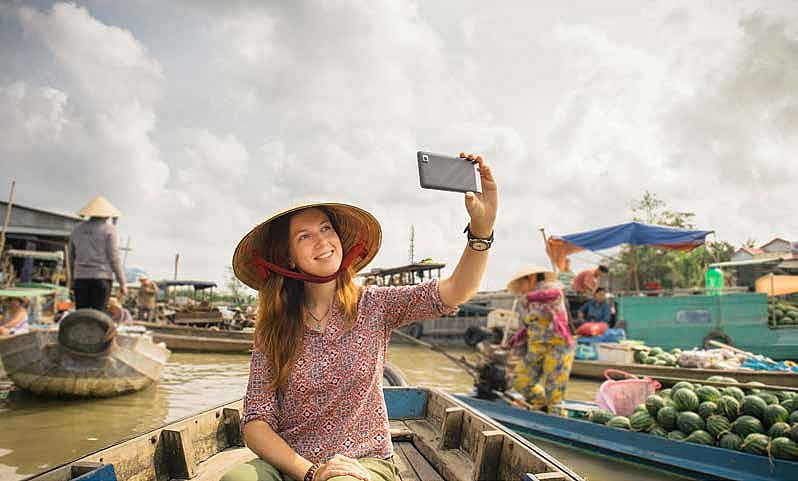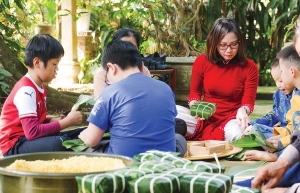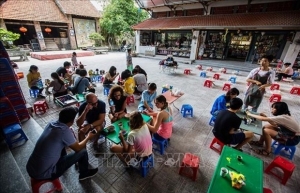Opportunity to earn millions from agricultural tourism
Ban Vat in Muong Sang commune has been a renowned community tourism destination in Moc Chau in recent years. The village has 50 households working in tourism, of which 15 households serve guests staying at home, the rest are weaving and farming groups to provide food and tourism products for homestays.
 |
| Opportunity to earn millions from agricultural tourism |
Luong Thi Tuoi, 30, owner of Moc Mien homestay in Ban Vat, said that her family’s previous income was only about $,1200 -1,700 per year, mainly coming from growing and selling local speciality fruits in Moc Chau like plums, apricots, and strawberries.
In 2017, Tuoi decided to open a homestay. In addition to income from serving guests, each month, her family also has additional income from selling agricultural products and providing tours to experience farm work for tourists.
“Foreign tourists and Vietnamese families living in urban areas love to experience the lives of local people. We give them the opportunity to participate in picking strawberries in the garden, planting rice, growing vegetables and weaving, in return, they will have to pay a fee of $10-15 each time,” she said.
Tourism based on agricultural activities has brought Tuoi’s family and many Ban Vat households an increase in income of about 10–20 times compared to before, now reaching about $30,000-33,700 per year. This number is expected to continue to increase as the number of visitors to Ban Vat is gradually recovering to pre-pandemic levels.
Agritourism encompasses tourism activities centred around agriculture, farmers, and rural landscapes.
The emerging global phenomenon of agritourism has found a fitting home in Vietnam, a country characterised by extensive agricultural landscapes and a predominantly rural population of about 63 per cent.
Recently, Vietnam has seen a surge in agricultural tourism. In the north, tours highlight rice cultivation and traditional crafts, like the Cultural Rice Fields Experience and Heritage Trail in Duong Lam Ancient Village of Hanoi.
In the Central Highlands region, offerings showcase agricultural diversity, like the Ethnic Minority Village Tour in Nam Giang district of Quang Nam province. High-tech agricultural tourism has seen significant tourist growth across different localities.
Despite limited statistics, reports indicate growing participation in agricultural tourism, fostering better incomes and economic development.
More than a decade ago, Tran Van Khoa, director of a travel agency in Hoi An, invested tens of thousands of dollars to support people in Cam Thanh commune to raise buffaloes for tourism, when he realised the need to explore the countryside area surrounding Hoi An was increasing.
Khoa’s company was the first with the idea of turning experiential activities related to buffaloes into tourism. The company is currently cooperating with about 30 buffalo farming households in Hoi An with the ability to reach 3,000 visitors per month.
He said that European, North American, and Australian tourists love to ride buffaloes around the fields or experience ploughing the fields with buffaloes. The average cost for each experience ranges $2-20 and the company will have to pay buffalo raising households about $630-840 each month.
“Many first-time visitors to Hoi An even bring foreign newspapers to write about this interesting experience. They told us that they must experience the tour before leaving the area,” said Khoa.
Besides its economic value, the presence of buffaloes in country tours has helped visitors feel the peaceful space and rustic life of the Vietnamese countryside. “Hoi An farmers have created millions of interesting pictures of the locality around the world,” he added.
According to the United Nations World Tourism Organisation, 10 per cent of global tourists will participate in ecotourism and agricultural tourism experiences by 2030 with revenue reaching about $30 billion.
Meanwhile, the proportion of tourists choosing traditional forms of tourism such as relaxation, sightseeing combined with entertainment and the events’ industry only increases by an average of 4 per cent each year.
Agricultural tourism is also facing the opportunity to develop strongly and become one of the typical and high-end tourism products of the Vietnamese industry, according to the assessment of Nguyen Anh Phong, deputy director of the Institute of Policy and Strategy for Agriculture and Rural Areas.
“Vietnam has rich natural resources and a unique culture, suitable for developing agricultural ecotourism. Of the total 1,300 tourist attractions managed by localities, about 70 per cent of them are in rural areas,” Phong said.
According to Dr. Pham Trang, RMIT lecturer of Tourism and Hospitality Management, the distinctive appeal of agritourism lies in the combination of natural and traditional cultural values in a rural setting. Thus, the participation of local communities and balancing the interests among participants in agricultural tourism are particularly important.
“One of the most crucial tasks is to avoid monotonous and repetitive products in agricultural tourism. Identifying key products and emphasising the uniqueness of each locality is vital,” she said.
Trang added that agritourism can adopt and embody many aspects of the green lifestyle, as successful models in other destinations such as Taiwan or Japan have shown.
The Fairy Lake Leisure Farm in Taiwan, for example, integrates lychee and coffee cultivation with processing into high-value items. It aims to offer tourists safe dining options, comfortable accommodation, enjoyable recreational activities, and trustworthy shopping experiences.
Meanwhile, the community of Yufuin in Japan created the YUFUIN PLUS brand to promote locally produced organic items and reduce reliance on imports.
“In Vietnam, given the small scale of agriculture, large farm tourism models may not be suitable. Future investments in agricultural tourism should focus on offering small-scale, refined, professional, and friendly services such as homestays and educational tours for school children,” Trang said.
“Complementary products for agricultural tourism should aim to supplement services related to healthcare, healing foods, natural cosmetics, and spa experiences.”
| Dr. Jackie Ong, senior program manager Tourism and Hospitality Management, the Business School RMIT University Vietnam
Vietnam’s rich cultural heritage, intertwined with a tradition of rice cultivation and vast orchards, sets the stage for this flourishing industry However, several challenges are impeding the realisation of agritourism to its full potential in Vietnam. One prominent issue lies in the realm of product development. Despite the country’s rich resources, the current landscape of agricultural tourism lacks a professional touch. Activities often emerge on a small, spontaneous scale, lacking a cohesive brand strategy. This has resulted in tourism products that struggle to captivate visitors’ interests. Agricultural tourism also faces service quality challenges, with many local farmers lacking the requisite skills for professional hospitality. This deficiency translates into simple and underexploited tourism products, limiting the potential for visitor spending. The scarcity of high-quality offerings and lack of comprehensive services further hinder the sector’s growth. Connectivity issues pose a third challenge, as collaboration between travel businesses and agricultural destinations remains constrained. This limitation inhibits the creation of integrated and appealing tourism products, both domestically and internationally. The shopping experience within agricultural tourism has its own set of challenges. Products often lack branding and attractive packaging, contributing to visitor hesitancy about quality and safety. Additionally, insufficient presentation and demonstration of production processes dampen the overall shopping experience. Human resource shortages, especially in service-oriented roles, present a fifth challenge. The limited availability of skilled labour impacts the delivery of high-quality and innovative agricultural tourism experiences. A dearth of training in operational management for agricultural destinations and craft villages exacerbates these constraints. Lastly, promotional and marketing efforts for agricultural tourism are deemed insufficient and non- specialised. Current strategies primarily focus on general tourism promotion, neglecting the distinct appeal of agricultural tourism products. |
 | The pride of agricultural backbone Vietnam’s agriculture has reaped many achievements last year. Minister of Agriculture and Rural Development Le Minh Hoan writes about how the sector will continue sailing forward in the new year. |
 | Legal synchronisation can unlock agro-tourism potential Agricultural tourism is being blocked from thriving in Vietnam due to the inevitably loose legalities currently in play. |
 | Hanoi develops rural, agricultural tourism Agricultural and rural tourism is currently considered one of the types that can help increase the length of stay and experience for visitors to Hanoi capital city. |
What the stars mean:
★ Poor ★ ★ Promising ★★★ Good ★★★★ Very good ★★★★★ Exceptional
Related Contents
Latest News
More News
- The destinations powering Vietnam’s festive season travel demand (December 04, 2025 | 18:33)
- Vietnam named among the world’s most exciting winter destinations (December 04, 2025 | 15:10)
- Phu Tho emerges as northern Vietnam’s new tourism hub (December 01, 2025 | 17:00)
- Vietjet completes Airbus A320/A321 updates ahead of deadline (December 01, 2025 | 09:49)
- Vietjet resumes Con Dao flights from early December (November 28, 2025 | 15:24)
- Free tickets, Lunar New Year promotions on offer at Vietjet Mega Livestream (November 26, 2025 | 15:32)
- Scandinavian Airlines and Vietnam Airlines broaden agreement with new routes (November 25, 2025 | 17:04)
- Halong Cruise Port welcomes over 3,100 international visitors (November 12, 2025 | 18:06)
- Vietnam.travel climbs to second place in Southeast Asia website rankings (November 12, 2025 | 18:01)
- Cat Ba named among Southeast Asia’s top island adventures (November 11, 2025 | 18:09)


 Tag:
Tag:





















 Mobile Version
Mobile Version